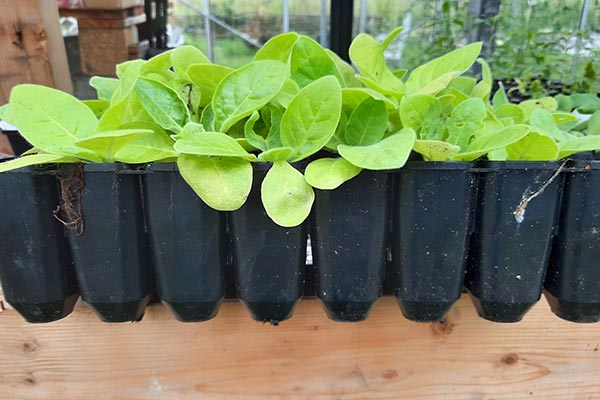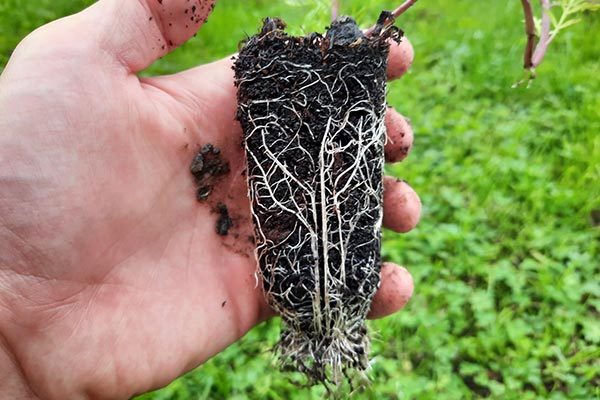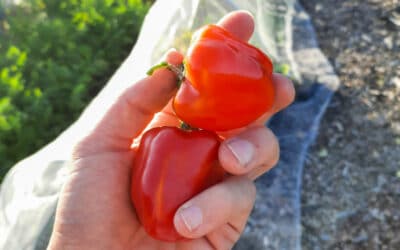As a gardener, we regularly come across terms that require a lot of research to understand what they mean. “Root Trainers”, the subject of this blog, is just such a term. Based on our findings, we will give you some tips on the use and effect of so-called “Root-Trainers” in this blog.

What are Root-Trainers?
The term root-trainers gives it away. They are deep (often narrow) pots designed to allow the roots of plants to grow as deep as possible. Peas, for example, are typical plants that naturally develop a root system that goes as deep into the earth as possible. When fully grown, this can reach up to 60 centimetres! To ensure that they can grow a nice deep root system before they go into the ground, we use root trainers.
So, a root-trainer is nothing else than a deep, narrow pot or tray that allows the roots of plants to root deeper and straight down. Often they also have larger air holes at the bottom so that the roots stop growing when they get outside the pot. This is called “Air-pruning”. This means that no long roots grow outside the pot or roots wrap around themselves, but rather many thick roots inside the pot because the plant receives a signal that the root cannot grow any further and starts again from the top..

How do you use a root trainer?
Depending on the type of root trainer, there are different methods. Of course, you first have to look at what you want to grow, what kind of roots they should have and how long they should stay there. Suppose you intend to grow trees, then you will need rather large cells to provide space for the large root network. For a pea, which can be planted out fairly quickly, a less deep and smaller cell is already sufficient.
In addition, you have to look at what kind of compost you are going to use. Of course, this again depends on what you are going to grow, but we often choose a compost that holds water well, so that we do not have to water too often.
After you have chosen the right size of grow cells and the right type of compost, it is time for the germination process. Think especially about the temperature at which the seeds germinate best. If you want to know more about this, you can always have a look at our blog about growth temperatures or about the use of heat mats.
Of course, your seedlings need light and love afterwards until they are big enough to go out into the world. Depending on the tray, repotting will be different. Traditional root-trainers often use a fold-out system and a rack to hang them in. You then take the cell out of the rack, unfold it and carefully lift the compost clump out of the tray and into the soil. The new variant root trainer of Containerwise, for example, is actually similar to your standard sowing tray but then extra deep. Instead of an opening sleeve, you can use the hole in the bottom of the cells to push the cutting out of the cells. Because the young plant has created enough roots, the root ball in the cell is a compact unit that you can easily handle.
Watering and proper compost
Important to know is that root-trainers sometimes dry out faster than your standard 9 cm pots. This is because root trainers usually have big drainage holes and sometimes even holes on the side that air dry the compost quicker than normal. But if you use a well-watered compost, you certainly don’t have to worry about it. We ourselves often use the Biological Garden Compost of the Welkoop (Netherlands). This seems to be very good at retaining water and it has enough nutrition to grow big healthy plants.

What can you grow in a Root Trainer?
Of course, the complete list is too big to post here, but think mainly of plants that like to form a deep root system. Peas, beans, peppers, sunflowers, corn, fennel and, of course, virtually all trees. It also works well for annual flowers that need to be sown early in the season. This gives them plenty of room to grow roots without becoming rootbound.

Advantages of using Root trainers
There are a few advantages in using root trainers that are important to us.
- You get deeper and straighter roots;
- The plant is less likely to become root bound;
- And we suffer less from Transplant Shock and root damage when repotting;
Deep and straight roots.
The big advantage of using root trainers is the way roots grow. Roots in a root-trainer often grow straight down and are then stopped at the bottom by the air-pruning. The plant shoots down a new root to try again, forming a strong network of roots ready to go into the ground. In addition, deep roots are desirable because they allow plants to collect water deep in the soil, and they stand firmer in the soil than plants with superficial roots.
Less fast root bound
In larger round pots roots often grow in circles around themselves. This causes the roots to become entangled in each other and it can sometimes be difficult to break them out again. Most plants bought in garden centres suffer from this. They have been in the round pot for a long time and have built up so many roots that they have trouble finding nutrition once they are transferred to the garden. If you do buy plants in a garden shop, it is a good idea to loosen the roots at the bottom so they can follow their own path again. Because the root-trainers promote deep growth, roots are less likely to wrap around.
Less transplant shock
By using a root-trainer you also have less trouble when repotting your plants. The roots are ready to grow straight down. So they can quickly look for water and nutrition. You will notice that e.g. corn or peas need less time to develop new roots if you repot them from a deep tray.
Disadvantages of root trainers
The biggest disadvantage of using root trainers is often the loss of moisture. Because there are usually more holes in an open root trainer, it can happen that your soil dries out more quickly. So make sure, especially during the germination process, that the soil is sufficiently moist.

Conclusion
Root-trainers are useful in pre-sowing deep-rooting plants such as corn, peas and annual flowers that need to be planted early in the season to be ready in time. By using them, you will have less transplant shock and less chance of plants developing poorly due to root bounding. We prefer to use the 40 cell deep as root trainer. This is the best depth for most deep-rooting plants.





0 Comments